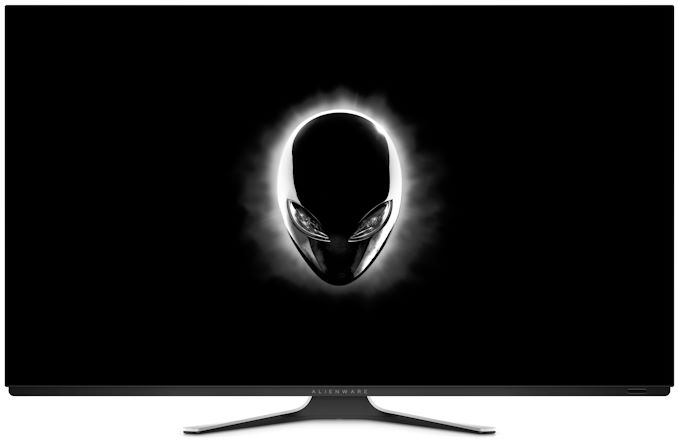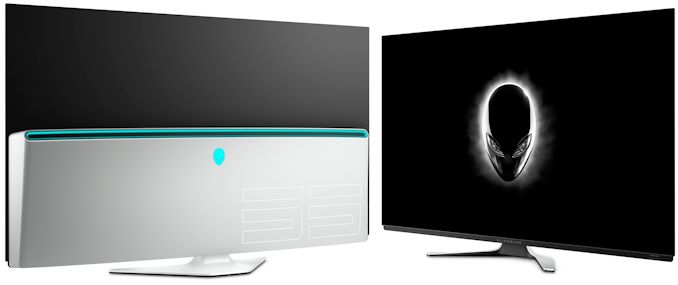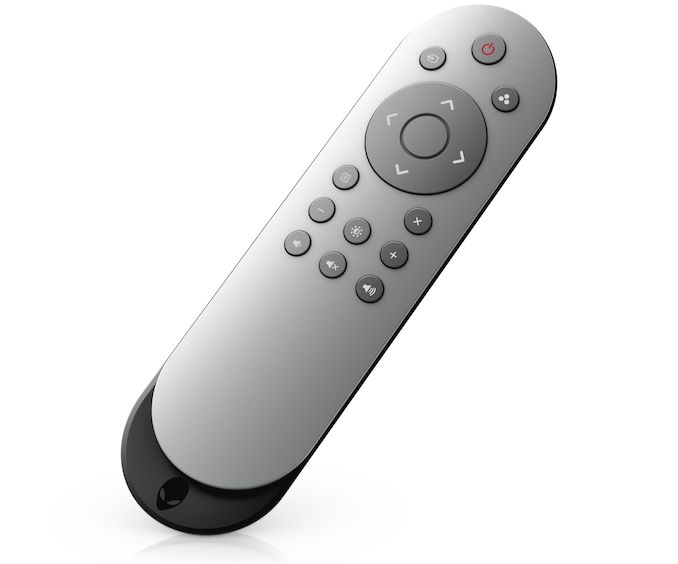Dell Launches 55-Inch Alienware OLED Display: 4K at 120 Hz with Deep Blacks
by Anton Shilov on August 19, 2019 5:00 PM EST
Today at Gamescom, Dell has officially launched its new flagship OLED gaming monitor, the Alienware 55. First demonstrated back at Computex, the display uses a 4K OLED panel featuring a 120 Hz refresh rate, making it among the fastest 4K monitors available. The Alienware 55 supports AMD’s FreeSync variable refresh rate technology, which is what sets the monitor apart from OLED UHDTVs, yet not in its HDR implementation.
The Alienware 55 is based on a 55-inch OLED panel featuring a 3840x2160 resolution, 400 nits peak brightness, a 130,000:1 contrast ration, a 0.5 ms gray to gray response time, as well as a 120 Hz maximum refresh rate. The screen can reproduce 98.5% of the DCI-P3 color gamut, which is comparable to accuracy of professional LCD displays. The monitor also has an anti-reflective coating with 2H hardness for additional clarity when used in bright days.
The key feature set of the Alienware 55 is a combination of its technologies as well as its size. OLED computer displays are rare in general, and this one is the industry’s first OLED monitors for gamers. The product is not without caveats though: despite the use of OLED technoloy, this is not an HDR monitor. In fact, Dell says nothing about Alienware’s 55-incher supporting HDR10 or Dolby Vision transports; so regardless of what the panel can do, it would appear that the monitor itself doesn't support any HDR input formats.
| Alienware 55 (AW5520QF) Display Specifications | ||
| Panel | 55-inch OLED | |
| Resolution | 3840 × 2160 | |
| Refresh Rate | 120 Hz | |
| Response Time | 0.5 ms gray-to-gray | |
| Brightness | Peal: 400 cd/m² | |
| Contrast | 130,000:1 | |
| Viewing Angles | 120°/120° horizontal/vertical | |
| Color Saturation | 98.5% DCI-P3 | |
| Display Colors | 1.07 billion | |
| 3D-LUT | ? bits | |
| Pixel Pitch | 0.3108 mm² | |
| Pixel Density | 81 PPI | |
| Anti-Glare Coating | 2H | |
| Inputs | 1 × DP 1.4 4 × HDMI 2.0 |
|
| USB Hub | Quad-port USB 3.1 Gen 1 hub | |
| Audio | 2 × 14 W speakers 3.5-mm mini jack S/PDIF |
|
| Mechanical Design | Chassis Colors: black, metallic, AlienFX RGB lighting |
|
| Power Consumption | Idle | 0.3 W |
| Active | 100 W ~ 390 W | |
The Alienware 55 comes with three HDMI 2.0 inputs as well as one DisplayPort 1.4 connector, with the latter being the second oddity in today's announcement. With full 4:4:4/RGB color, DisplayPort 1.2 is limited to 60Hz; you need DisplayPort 1.4 for 4K@120Hz with 8bpc color. So for what Dell is doing, there's an error in the specifications or compromise somewhere. Either DisplayPort 1.2 is right and they're doing something akin to 4:2:2 choma subsampling to make 120Hz work, or this is not a true 120Hz monitor at all – and instead it's a 60Hz monitor with black frame insertion, a common tactic for TVs. At this point we're not sure which it is, and we've reached out to Dell for clarification.
Update: Dell has gotten back to us, confirming that their original spec sheet was wrong, and that the monitor comes with DisplayPort 1.4 rather than 1.2. So the display does in fact have enough bandwidth for 4K@120Hz with 8bpc color.
Moving on, the display has a quad-port USB 3.1 Gen 1 hub, a headphone output, and an S/PDIF line out. When it comes to audio, the display has two 14 W speakers that were co-designed with Wave Maxx Audio.
Just like other large displays, the Alienware 55 comes with a remote control to adjust brightness, regulate audio and perform other operations.
Dell will start sales of the Alienware 55 display starting September 30 at $3,999.99.
Related Reading:
- Dell at CES 2019: Alienware 55-Inch 4K 120 Hz OLED Gaming Monitor Showcased
- Dell Updates Alienware m15 & m17 Gaming Laptops: New Chassis, New Processors, & Optional OLED Display
- LG to Start Production of OLEDs in China Next Month, Set to Double OLED Output
Source: Dell













47 Comments
View All Comments
lilkwarrior - Wednesday, August 21, 2019 - link
I'm confused; this monitor is overall worse than OLED TVs released this year (LG's Dolby Vision HDMI 2.1 4K@120hz TV)Only things this monitor does meaningfully better is have a 0.5ms response time & a DP 1.4 port oriented for gaming.
jseliger2 - Monday, August 19, 2019 - link
I can't be the only one wondering where a normal-sized desktop monitor is. Shouldn't the 30" version be easier and cheaper than the 55" version? Why not start at 30"?DigitalFreak - Monday, August 19, 2019 - link
LG makes all the OLED panels for TVs and monitors right now. There's economies of scale producing the same size panel for both TV and monitor use (55, 65, 77").jabber - Monday, August 19, 2019 - link
So it's an expensive rebranded TV with some gaming ability. Hmmm I prefer one or the other. Not a compromise if I'm spending that much.DigitalFreak - Monday, August 19, 2019 - link
I feel sorry for anyone using this as a desktop monitor. I hope you enjoy seeing your taskbar and desktop icons burned into the monitor. OLED is fine for TV and most gaming, but terrible for static desktops.lilkwarrior - Wednesday, August 21, 2019 - link
That's BS. Can you clarify for us readers what experience you have using OLED monitors for desktop use?Also, even Dell OLED monitors before this long ago had plenty of safeguards for this problem. I think you're echoing urban myths as though they are fact.
RSAUser - Wednesday, August 21, 2019 - link
It's still a fact last time I checked, especially taskbar.Most work-around right now revolve around having a bad max brightness, otherwise they all burn in.
lilkwarrior - Thursday, August 22, 2019 - link
No, the most effective workaround is exercise common sense to auto-hide the taskbar & have. A screensaver; a persistent task bar takes away valuable real estate from focusing on the contentAlex Topfer - Monday, August 19, 2019 - link
does anyone buy a $4k monitor and use the built in speakers?Eliadbu - Monday, August 19, 2019 - link
Wait for burnins especially if you display static images on high brightness.